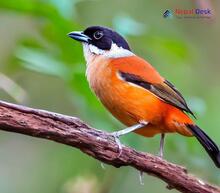Situated within the stunning Himalayas, Nepal houses a variety of mesmerizing wildlife. Among these enchanting creatures is the Pteruthius genus, a collection of passerine birds that are part of the Vireonidae family. These often-overlooked birds provide a remarkable insight into Nepal's complex ecosystem. Here, we'll delve into the Pteruthius genus and its importance in this magnificent region.
Taking a Closer Look: Delving into the Pteruthius Genus
The Pteruthius genus is made up of several small bird species such as the White-browed Shrike-babbler, Black-eared Shrike-babbler, and Green Shrike-babbler. These birds are distinguished by their striking vocal abilities and unique color patterns, causing them to stand out amongst thick greenery. They generally reside in subtropical and tropical montane forests, thriving at elevations between 900 and 3,600 meters.
Behavior and Adaptations
Birds belonging to the Pteruthius genus exhibit fascinating behaviors that have evolved to match their exclusive surroundings. They primarily consume insects and tiny fruits by actively exploring tree branches, twigs, and undergrowth for prey. Their zygodactyl feet (with two toes pointing forward and two pointing backward) enable quick and agile traversal through tree canopies.
The social nature of shrike-babblers is another noteworthy characteristic. Often seen in mixed-species groups, they cooperate with other bird species when searching for food or defending against predators, providing safety in numbers.
Conservation Initiatives: Safeguarding Nepal's Feathered Treasures
Like many species living in our world's cherished ecosystems, threats such as habitat destruction and climate change have started to impact birds from the Pteruthius genus. Thankfully, numerous conservation projects are being implemented to protect Nepal's biological diversity. National parks like Langtang National Park and Gaurishankar Conservation Area offer sanctuary to various species, including the enigmatic shrike-babblers.
Additionally, researchers are helping preserve these one-of-a-kind birds by studying their distribution, behavior, and population dynamics. Citizen science programs provide a platform for locals and tourists to contribute to these efforts. Monitoring and reporting shrike-babbler sightings can lead to crucial data that inform conservation strategies.
To Conclude
The Pteruthius genus is an essential part of Nepal's abundant natural heritage, which features a captivating assortment of avian species. By supporting conservation initiatives and raising awareness about these lesser-known birds, we can work towards securing the ongoing survival of these winged wonders amid the awe-inspiring landscape of Nepal.




